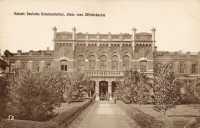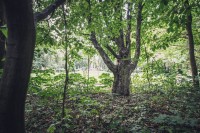The Modlin Fortress is one of the largest fortifications in Europe comparable to the French Verdun Fortress, and constitutes the international monument of the defensive architecture.
It consists of a set of reinforcements expanded a number of times which embraces mostly French, Russian and Polish fortification conceptions.
The Modlin Fortress was established by Napoleon, and in 1813, it was captured by Russians. It had been intensely expanded by subsequent Tsars and within the time span of 90 years, it had become a spacious defensive complex covering the area of 200 sq. km. During World War I, the Fortress was conquered by Germans and after the war activities had ended, it fell under the command of the Polish Army.
The Modlin Fortress contributed also to the Polish-Bolshevik War in 1920. In the mid-war times, it became an important centre of military education. After the outbreak of World War II in September 1939, it was a major stronghold of the defence of the capital of Poland. The heroic struggle ended as late as on 29 September, a day after the surrender of Warsaw which happened a day earlier.
After World War II, the Fortress became again a centre of military training. At present, is not playing a military role any longer but due to rich history and preserved unique facilities it is a place willingly visited by tourists.
The Park of Three Cultures casts more light on the turbulent history of the Modlin Fortification on the basis of cultures of French, Russian and Polish nations which have exerted the greatest influence on its two hundred years old history and unique architecture creating the cultural heritage of the Modlin Fortress of the European importance.
Walking around the Park we can experience the mixture of these cultures. Three main park alleys bear their names. Additionally, at each of them the boards were placed informing on the influence of the given culture on the history of the Modlin Fortress.
The History
The park was established by the Russians at the turn of the 19th and 20th centuries or at the beginning of the 20th century on the combat slope built in the Napoleon’s times. The miners’ pavements might have been preserved under the slope which are inaccessible today. The park situated in the central part of the Modlin Fortress was conceptually linked with the neighbouring Tsarist blocks and the officer’s canteen. After Poland had regained independence, it was tidied up and named the Romuald Traugutt Park. In those times, it stretched up to the Narew River and was crowned with the viaduct at the Ostrołęka Gate connected by stairs with a sailors’ marina.
On 15 August 1923, a correspondent of the “Polska Zbrojna” military magazine wrote that on 5 August that year, [on the 59th anniversary of executing Traugutt for his participation in the January Uprising] a ceremonial opening and consecration of the park was held which “was completed and tidied up due to the efforts of the Fortress commander, Col. [Edward] Malewicz.”
The present area of the park was shaped after World War II. Bearing no official name, it stretched between the canteen and the Tsarist blocs. The set of park avenues was altered then and the asphalt and small architecture were introduced including the band shell and the elements symbolising the military units which stationed in the Fortress (stone obelisks).
The name The Park of Three Cultures has been functioning since 2014 and it refers to three cultures which had the greatest influence on the Modlin Fortress. Due to the effort of the Nowy Dwór Mazowiecki authorities, the revitalisation of the park was carried out on the basis of the historic set of the park alleys in a reference to its times of glory. The revitalised space has become a centre of many cultural events addressed to residents and tourists.
Architecture
The crucial architectural conception concerning tidying the Park of Three Cultures referred to the historic set of paths and squares compatible with the original composition from the turn of the 19th and the 20th centuries. To achieve this purpose, the course of the existing alleys was corrected and the course of the historic paths was recreated. In this way, the communication route has regained its original coherence. The majority of alleys have a mineral surface which matches the surrounding greenness and refers to the historical substratum. The alley with an asphalt surface is used by amateurs of an active recreation (bicycle riding, roller skating, etc.).
The recreated historic composition of the park is based on arches (park alleys) and a circle (squares). This motif was also used in the elements of small architecture and while designing the stage. The stage rails reflect the characteristic balustrades placed on the level of the Officers’ Canteen’s roof. The squares have been paved by concrete slabs which were once used in the representative places of the Fortress (for instance, at the entrance to the canteen).
There are two squares in the park – The Monument to the Modlin Defenders of 1939 is situated on one of them and the stage in the shape of a garden house is situated on the other one. It refers to the architecture of the times when the park was established.
Residents and tourists while using the park can experience the mixture of the three cultures which had a greatest impact on the creation and development of the Modlin Fortress. The three main park alleys bear the names of these cultures. At each of them, information boards were placed which inform on the influence of a given culture on the Modlin Fortress and its European cultural heritage. We invite you to take walking tours and to discover the Park of Three Cultures, and then, the entire Fortress!
Nature
The most numerous plants and trees in the park include locusts, maple trees, ash trees and poplar trees. The greatest density of trees over 120 years old can be observed in the middle arch between the Polish and Russian alleys (the vicinity of the stage). At the back of the Monument to the Modlin Defenders, there is the only mountain ash tree which is over 100 years old and is particularly interesting due to its joined branches creating a huge tree trunk of a monumental nature, unfortunately, withering. It is a strictly protected specimen.
These are not the only natural curiosities in the Modlin Fortress. At the entrance to the Fortress cemetery, there is a monument of nature – the polar tree. The protected area NATURA 2000 includes the Modlin Forts (a winter habitat of the chiropters) and the entire section of the Vistula River in Nowy Dwór Mazowiecki.
We invite you to walk around and discover the Park of Three Cultures and to make it a starting point to see the entire Fortress!





